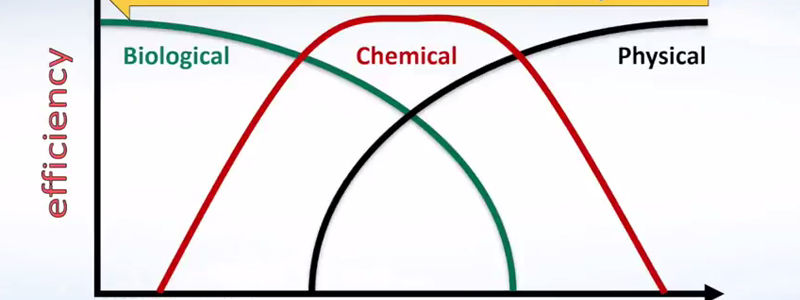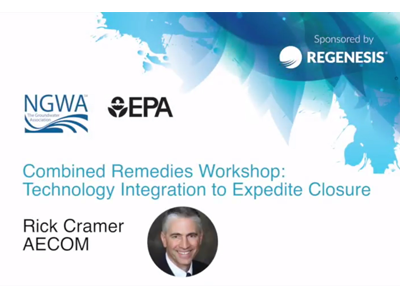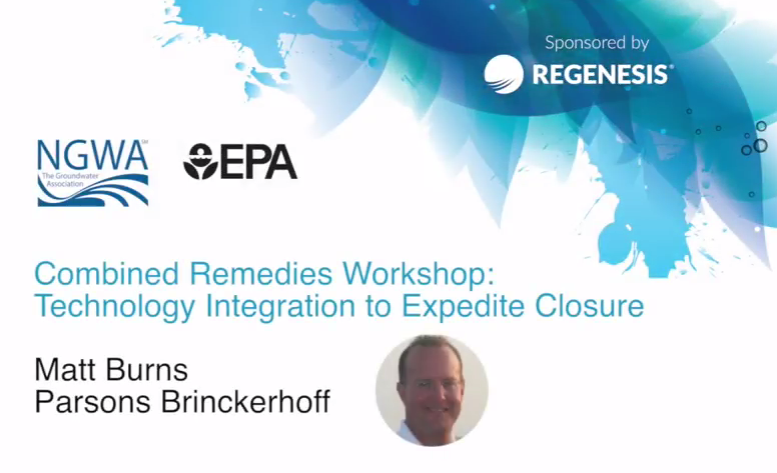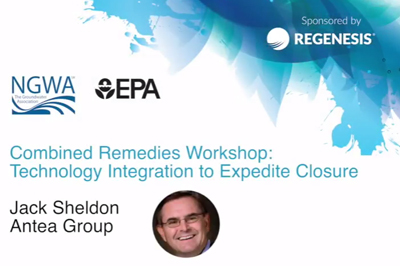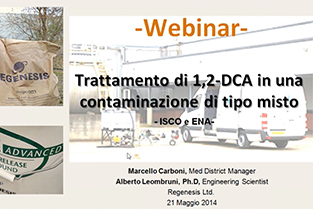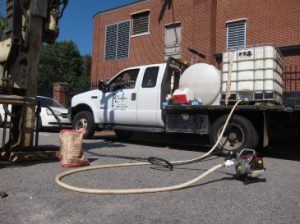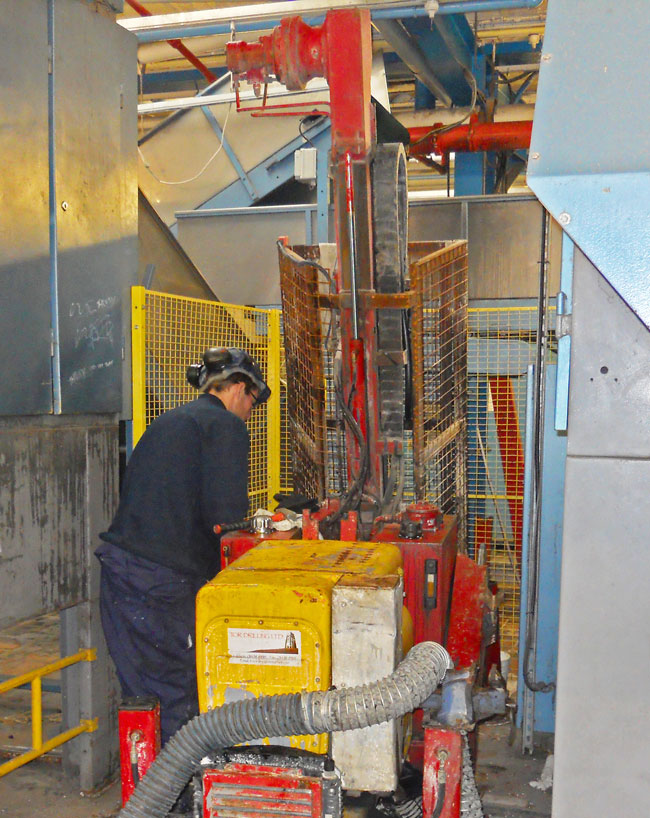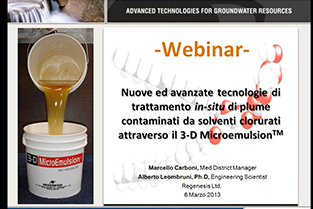Combined Remedy Synergies – Quantified Performance Benefits
First broadcast: 26 January 2016
Speakers: Jeremy Birnstingl, VP of Environmental Technology at REGENESIS
Today, the variety of remediation technologies available is a direct reflection of the variety of performance characteristics they each present, be it in the balance of achievable cost vs. time, the degree of intrusion necessary for their furtherance, their optimum concentration range for maximum efficiency, or their suitability to a given geological, hydrological, or geochemical setting.
In this presentation originally given at a workshop presented by NGWA, US EPA, and REGENESIS®, Jeremy Birnstingl, VP of Environmental Technology at REGENESIS, discusses:
- The inherent shortcomings of the widespread single-technology design predisposition in the remediation industry today
- The physicochemical principles favoring the use of integrated remedial approaches
- Remediation that is designed to secure efficiency and cost benefits to all stakeholders
View this free webinar
Why Focus on the Geology? by Rick Cramer, AECOM
First broadcast: 26 January 2016
Speakers: Rick Cramer, Director of Science at AECOM
Subsurface geology defines the “plumbing” (permeable pathways) that largely controls the subsurface heterogeneity responsible for groundwater flow and contaminant migration at complex sites. A focus on the geology is imperative for understanding fluid migration in the subsurface. The 2013 National Research Council study regarding complex contaminated groundwater sites concluded that, due to inherent geologic complexities, restoration of these sites is likely not achievable. It is time for the environmental industry to focus on modern geologic methods to understand the subsurface. This presentation shows how existing data and established geologic analyses can move groundwater remediation projects forward through an improved, quantitative conceptual site model.
This presentation was originally given by Rick Cramer, Director of Science at AECOM, at a workshop presented by NGWA, US EPA, and REGENESIS®. We are excited to announce that a recording of this presentation is now available.
View this free webinar
Effective and Sustainable Combined Remedies using Single Application of Multi-functional Ammendments
First broadcast: 26 January 2016
Speakers: Matt Burns, Practice Leader WSP | Parsons Brinckerhoff
The combined remedy approach to groundwater remediation optimizes contaminated site cleanup as measured by technical efficacy and sustainability. Regardless of the potential for improving site cleanups, however, there are still obstacles limiting the implementation of combined remedies. These obstacles can often be circumvented by employing multicomponent and multifunctional remedial amendment formulations delivered with a single application. Case studies are presented that demonstrate efficacy of this combined remedies approach. We are excited to announce that a recording of this presentation is now available.
This presentation was originally given by Matt Burns, Practice Leader at WSP | Parsons Brinckerhoff, at a workshop presented by NGWA, US EPA, and REGENESIS®. We are excited to announce that a recording of this presentation is now available.
View webinar recording
Environmental Liability Transfer Sites: Well-Suited to Combined Remedies by Jack Sheldon, Antea Group
First broadcast: 26 January 2016
Speakers: Jack Sheldon, Senior Consultant at Antea Group
In this presentation originally given at a workshop presented by NGWA, US EPA, and REGENESIS®, Jack Sheldon, Senior Consultant at Antea Group, discussed how environmental liability transfer sites are generally well-suited to combined remedies due to the complexity and timeframes of this project type. In his presentation, he explores an example site in California that highlights the conceptual model development process, the evaluation of a range of remediation technologies, and the selection of technologies for source treatment, plume treatment, and polishing. A recording of this presentation is now available.
View the recording of this free webinar
Trattamento di 1,2-DCA in una contaminazione mista
First broadcast: 21.05.2014
In questo webinar viene illustrato un importante caso applicativo di trattamento in situ di un acquifero contaminato nel Regno Unito. Presso un sito industriale in attività è stato effettuato con successo il trattamento di un esteso plume inquinante che presentava concentrazioni superiori a 8.000 μg/L di dicloroetano (DCA), con contestuale presenza di idrocarburi e cloruro di vinile.
L’intervento è stato realizzato combinando Ossidazione Chimica in Situ (ISCO) con biodegradazione aerobica potenziata, co-applicando i prodotti RegenOx® e ORC Advanced®, utilizzando la modalità direct push ed effettuando un unico intervento di applicazione.
Il webinar illustra le caratteristiche del sito, sia in termini geologici e idrogeologici che per quanto riguarda le caratteristiche di contaminazione e la definizione del modello concettuale. Vengono poi analizzate le tecnologie di bonifica potenzialmente utilizzabili e viene fornita una descrizione di dettaglio delle tecnologie utilizzate e dell’intervento eseguito, analizzando in ultimo i risultati ottenuti.
Guarda la registrazione webinar
A Data-Intensive Review of Enhanced Reductive Dechlorination (ERD) Projects in the USA, for the Treatment of Chlorinated Solvents
First broadcast: 14 January, 2014
Speakers: Dough Davies (REGENESIS)
Recording Available | The use of ERD for contaminated site remediation is well-documented and offers a range of distinct benefits including: in-situ application, regulatory acceptance, minimal site disturbance, cost-effectiveness and well understood performance measurement.
This presentation is designed specifically to provide address common questions, including duration, cost, daughter product formation, and in-situ chemical oxidation (ISCO) options, through a systematic review of various on-going and recently completed ERD projects.
View webinar recording
From Free Phase to Non-detect under Active Drycleaning Facility
First broadcast: 30 July, 2013
Speakers: George Flower (Hyder Consulting) and Gareth Leonard (REGENESIS)
This webinar explains how Enhanced Reductive Dechlorination using REGENESIS’ HRC product range was used to successfully remediate Dense Non-Aqueous Phase Liquid (DNAPL) and dissolved phase contamination in clays and send lenses to a depth of 10m BGL, under an active industrial dry cleaning facility contaminated with tetrachloroethene (PCE).
Prior to treatment, the contamination showed little sign of natural biological attenuation and a costly and disruptive excavation strategy was being considered. Hyder showed that remedial objectives could be achieved by a targeted in situ remedial approach. From a single HRC injection by REGENESIS, very low dissolved phase targets were met, gaining regulatory ‘closure’ and client satisfaction – at a fraction of the cost of excavation and without disturbing site activities.
This project has subsequently been the winner of two remediation awards in the Brownfield Briefing Awards 2013:
- Award for Best In Situ Remedial Project – Judges’ comment: “This project was an excellent example of how existing technology can be thoughtfully applied”
- Award for Best Project Closure/Verification Process – Judges’ comment: “This highly technical groundwater remediation project impressed the judges. It demonstrated a range of techniques that were used to gather high quality data to monitor the progress and the success of the project.”
View the webinar recording
Una introduzione al PersulfOx (persolfato catalizzato)
First broadcast: 10.04.2013
In questo webinar è illustrata una panoramica complessiva sul composto ossidante PersulfOx®, un reagente per l’ossidazione chimica in situ (ISCO) che distrugge i contaminanti organici presenti nelle acque sotterranee e nel suolo attraverso reazioni chimiche potenti ma controllate. I contaminanti più comuni trattati mediante tale ossidante sono idrocarburi, solventi clorurati e composti ossigenati. A base di persolfato di sodio catalizzato, è un reagente ISCO autoattivante e quindi relativamente sicuro e di facile utilizzo.
Il webinar affronta nel dettaglio i seguenti argomenti:
- Principi di base dell’ossidazione chimica
- Formulazione e caratteristiche del prodotto
- Fondamenti della catalizzazione del prodotto e principio di funzionamento dell’auto-attivazione che avviene mediante miscelazione con acqua
- Comparazione con il reagente ISCO RegenOx®, a base di percarbonato di sodio catalizzato
- Modalità di utilizzo: attività di miscelazione e iniezione, attrezzature, materiali compatibili con il persolfato
- Considerazioni relative alla sicurezza e DPI necessari, fattori da tenere in opportuna considerazione pur essendo un reagente di più facile utilizzo, non dovendo utilizzare sistemi tradizionali di attivazione
- Casi di studio reali
Guarda la registrazione webinar
Nuove ed avanzate tecnologie di trattamento in-situ di plume contaminati da solventi clorurati attraverso il 3-D Microemulsion®
First broadcast: 06.03.2013
Questo webinar si focalizza sull’utilizzo di tecnologie innovative per il trattamento di composti clorurati, ed in particolare sul substrato a rilascio controllato di idrogeno 3-D Microemulsion® (3DME).
3-D Microemulsion® è un composto iniettabile elettro-donatore, unico nel suo genere, per il trattamento di acquiferi contaminati da solventi clorurati. Una volta emulsionato ed iniettato in falda, il prodotto è stato infatti appositamente ingegnerizzato per sostenere sul lungo termine (3-5 anni dal momento dell’iniezione) ed accelerare i processi anaerobici di biotrattamento di contaminazioni da PCE, TCE, DCE e di tutti quei contaminanti degradabili anaerobicamente, ottimizzando il processo in termini di costi-benefici. La sua capacità di auto-distribuzione grazie alla formazione di micelle consente inoltre di raggiungere raggi di influenza notevoli da ogni singolo punto di iniezione, facilitando e rendendo meno onerosi gli interventi di applicazione.
Durante il webinar sono affrontate le seguenti tematiche:
- Cenni sulla dealogenazione riduttiva
- Caratteristiche ed applicabilità del prodotto
- Casi applicativi in Italia e all’estero
- Domande ed approfondimenti

 Americas
Americas Europe
Europe Français
Français Deutsch
Deutsch Italiano
Italiano Español
Español